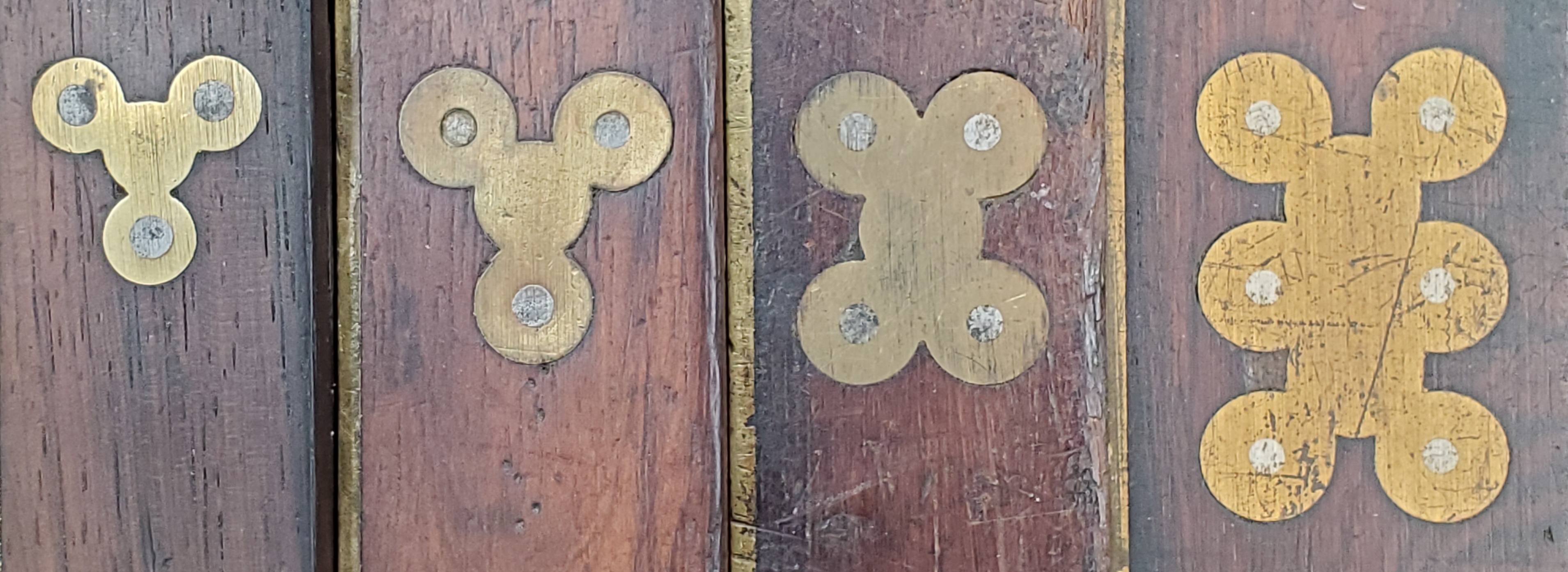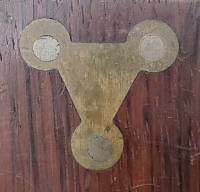Commonly Found Try Squares
Shown here are some commonly found try squares which feature uniquely identifiable escutcheons. This is not intended to represent all uniquely identifiable squares, nor every square someone may stumble upon. These are simply the squares that are most commonly found which also feature escutcheons which are hard to confuse with any others.
Stanley

Stanley’s rosewood handled try square was known as the No 20, and used these escutcheons from 1877 until about 1960. These squares were probably the most widely produced of all time and are the most commonly found squares today. Squares from 1877-1896 feature no groove in the handle and are not marked anywhere on the square. Post 1896 squares feature a handle groove and are marked with various trademarks and patent dates on the blade. Starting around 1935, “Stanley” was added in gold embossing on the handle. Stanley frequently sold their squares wholesale to hardware stores who would mark them with their own trademarks. No matter how a square is marked though, with this style of escutcheon, you can be guaranteed it was produced by Stanley of New Britain, CT. The three different sizes/styles shown here simply changed with the size of the square, and do not represent different models or time periods. You can view a complete type study of the Stanley No 20 here.
Disston & Sons

Henry Disston & Sons of Philadelphia, PA is most well known for their handsaw production, but they were also producers of many other tools, including squares. These are the second most commonly found after Stanley’s. Disston’s squares may be marked on the blade or the handle, and commonly are found not marked at all. Disston was also a prolific wholesaler and many of their squares can be found marked by hardware store’s house brands. The four sizes/styles shown here simply changed with the size of the square, and do not represent different models or time periods. This escutcheon was introduced in the 1880’s and continued through the 1940’s. The groove in the handle was introduced around 1915.
Greenfield Tool Co

Squares with this style of escutcheon appear to have been sold exclusively by the Greenfield Tool Co of Greenfield MA. It is not known if Greenfield (who was a prolific manufacturer of wooden planes) made these themselves, or contracted them out to another large firm. These squares were never marked and presumably were offered for the life of the company from 1851-1883.
S. A. Jones & Co

This triply symmetrical escutcheon can be found on squares bearing the mark of S. A. Jones & Co or Willis Thrall & Son, both of Hartford, CT. Frequently the squares can be found unmarked as well. Recent research shows that Jones and Thrall were likely partners as early as 1833 until Jones' death in 1865, and that the name of S A Jones & Co was in use on squares from 1833 until at least 1867. Thrall continued producing squares until at least 1877, possibly later. Squares marked Willis Thrall & Son are ones that were specifically sold at his physical hardware store in Hartford. Through the entire time of production, the partners also did a healthy wholesale business which resulted in many squares not being marked. Unmarked squares are the most common, followed by Jones marked squares, while Thrall marked squares are very uncommon.
Star Tool Co

The Star Tool Co was in business from 1872-1879 in Middletown, CT. They are best known for producing the Howard patent bevel which they marketed as the “Star” bevel along with the “Star” Square. These squares can be found with the Star trademark on either the handle or the blade, or sometimes both. Occasionally they can also be found unmarked. Models can have graduations on the blade or not, and can also feature extra back plating.